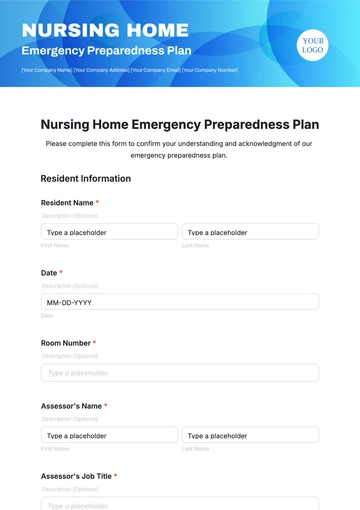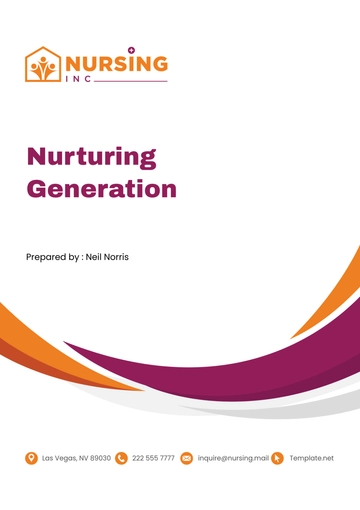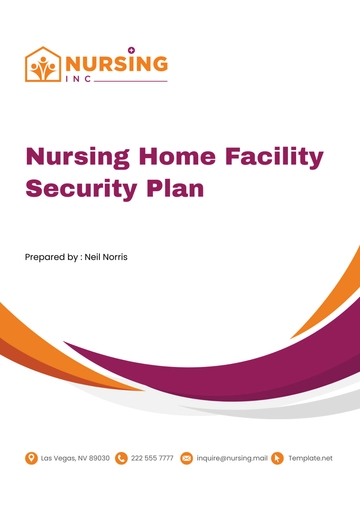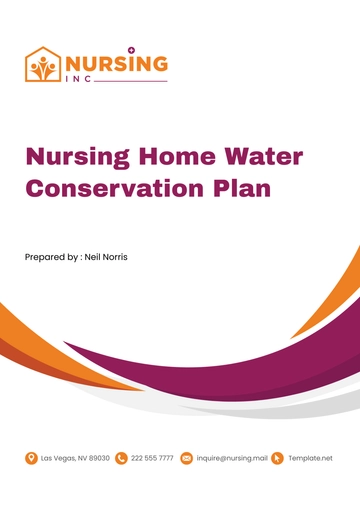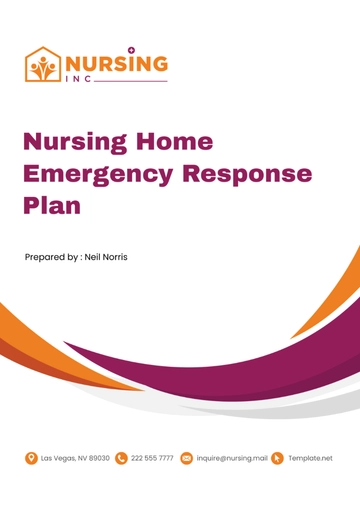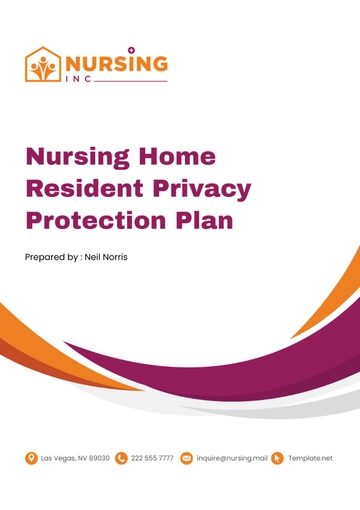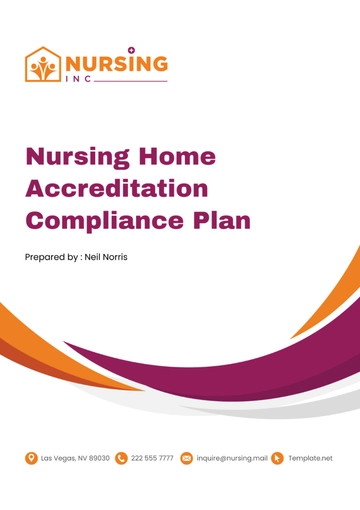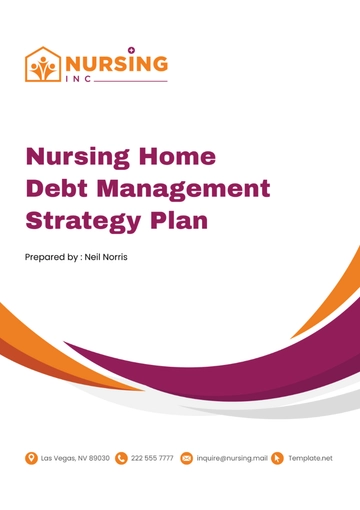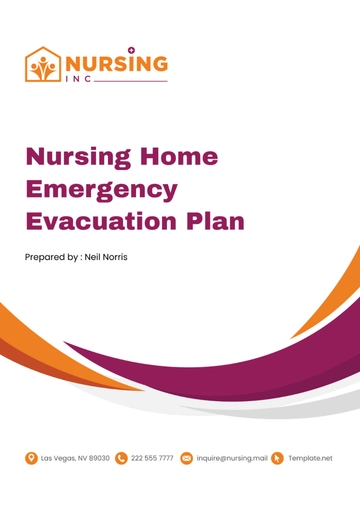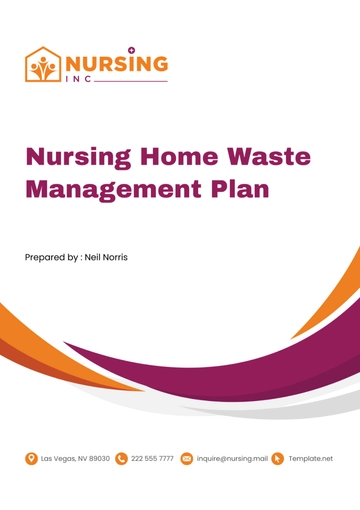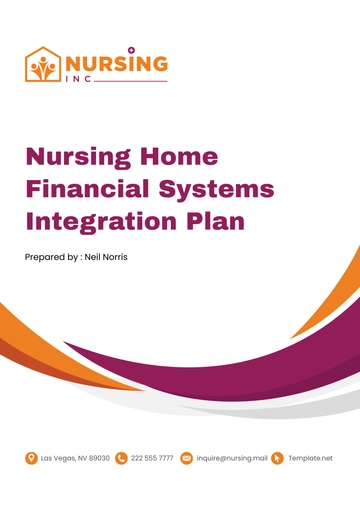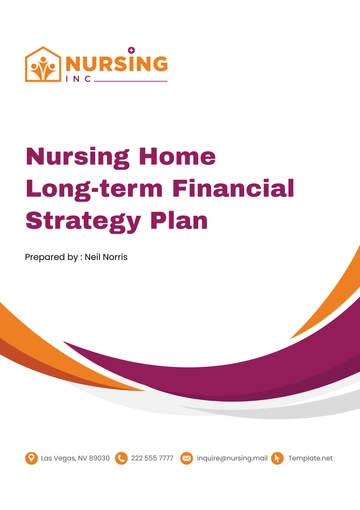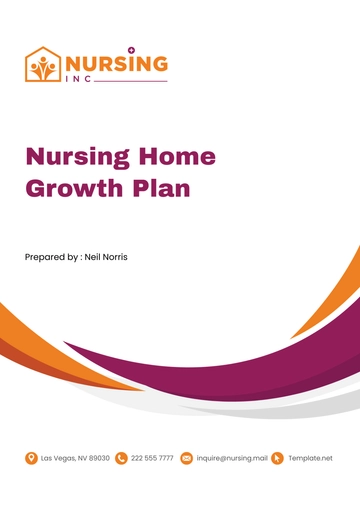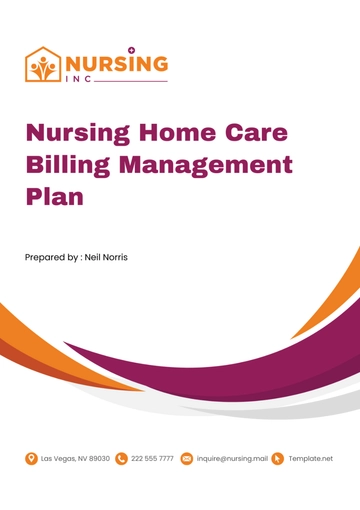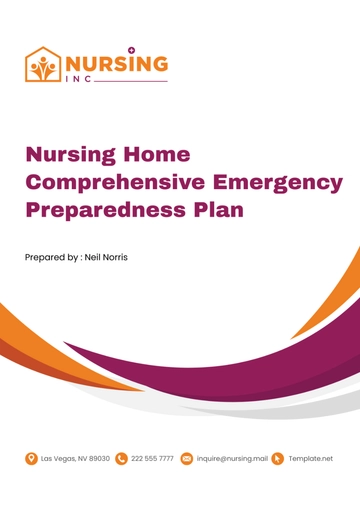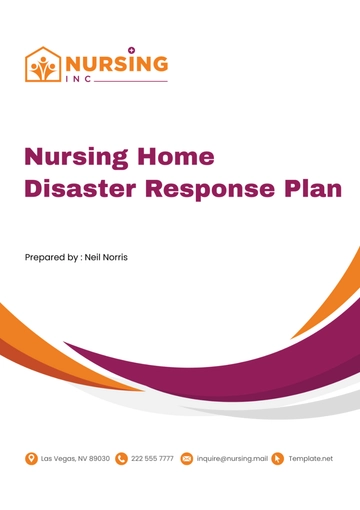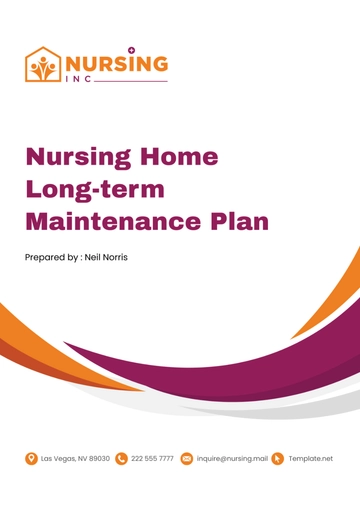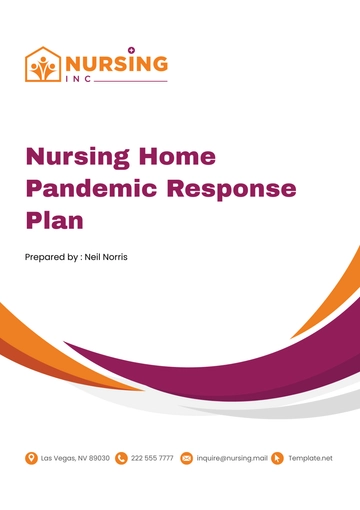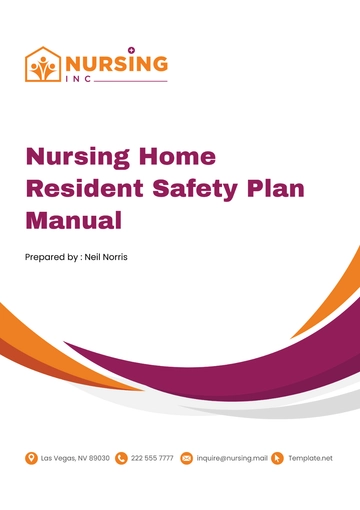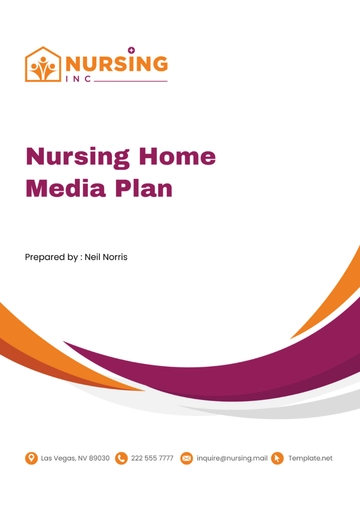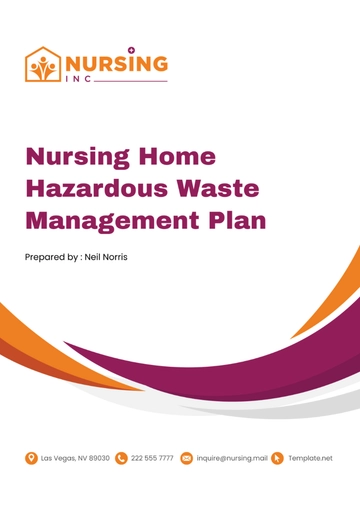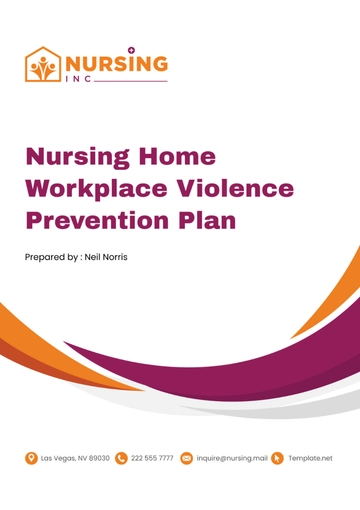Free Nursing Home Pandemic Response Plan
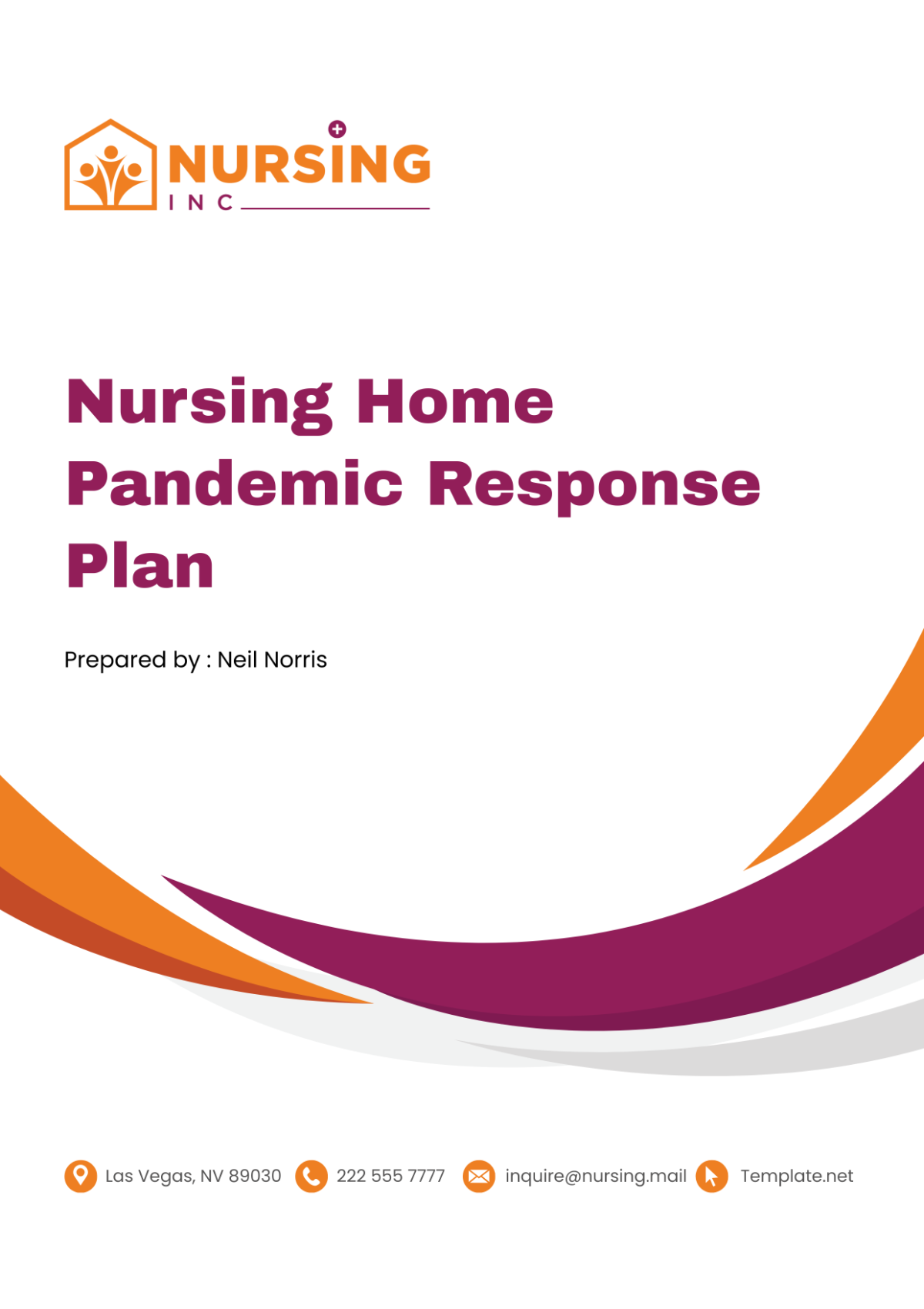
I. Pandemic Preparedness
[Your Company Name] commits to instituting a dedicated Pandemic Preparedness Committee, charged with the strategic development and vigilant execution of our comprehensive pandemic response strategy. This committee will be pivotal in maintaining a constant watch over evolving pandemic-related developments, assimilating data from both local and international health observatories, and adapting our protocols in alignment with the latest public health directives. Their role extends beyond surveillance, as they will also spearhead educational initiatives, ensuring that all staff and residents are well-informed about the current pandemic situation through regular updates and briefings.
To fortify our preparedness, the committee will also devise and periodically revise contingency plans tailored to a variety of potential pandemic scenarios. This includes establishing robust stockpiles of essential medical supplies, personal protective equipment (PPE), and sanitization materials, guaranteeing that [Your Company Name] remains well-equipped to safeguard the health and well-being of our community. Training programs will be developed and routinely updated to enhance the pandemic response capabilities of our staff, covering critical areas such as infection control measures, use of PPE, and emergency communication protocols.
Furthermore, [Your Company Name] will actively collaborate with local health authorities, hospitals, and other key stakeholders to ensure a coordinated and efficient response to pandemic threats. This collaboration will enable us to access real-time information, share resources if necessary, and participate in joint response efforts that benefit not only our residents and staff but the broader community. By embedding this culture of preparedness and collaboration, we aim to not only mitigate the impacts of a pandemic but also to emerge stronger and more resilient in the face of public health challenges.
II. Infection Prevention and Control
In the relentless pursuit of excellence in healthcare, [Your Company Name] implements a comprehensive infection prevention and control strategy, encapsulating enhanced cleaning and sanitation protocols, meticulous screening of staff and visitors, isolation protocols for suspected cases, and the rigorous enforcement of hygiene practices. This multi-faceted approach is designed to fortify our defenses against infectious outbreaks, ensuring a safe and secure environment for our residents and staff.
A. Enhanced Cleaning and Sanitation Protocols
We adopt a zero-compromise policy on cleanliness, deploying advanced disinfection technologies and procedures throughout our facilities. High-touch surfaces and common areas receive increased attention, with cleaning frequencies intensified during outbreaks to curtail virus transmission.
Area/Item | Cleaning Frequency | Cleaning Method | Disinfectant Type |
|---|---|---|---|
High-touch surfaces (door handles, light switches) | Every 2 hours | Wipe down | EPA-approved disinfectants |
Common areas (lobbies, dining halls) | 3 times daily | Mopping and wiping | Hospital-grade disinfectants |
Resident rooms | Daily & upon any new exposure | Wipe down & mopping | Non-toxic, EPA-approved disinfectants |
Bathrooms | Every 4 hours | Wipe down & mopping | Bleach-based cleaners |
B. Screening of Staff and Visitors
Vigilant screening measures are in place to identify and manage potential infection risks promptly. All staff and visitors undergo temperature checks and symptom assessments upon entry, with policies adapting dynamically to evolving public health guidelines.
Group | Screening Process | Frequency | Measures Upon Detection |
|---|---|---|---|
Staff | Temperature check & symptom questionnaire | At entry & every 4 hours | Immediate isolation & PCR testing |
Visitors | Temperature check & symptom questionnaire | At entry | Deny entry if symptomatic, advise medical consultation |
C. Isolation for Suspected Cases
A dedicated isolation wing is prepared for individuals exhibiting symptoms or having been exposed to infectious diseases, ensuring they receive prompt care while minimizing exposure to others. This space is equipped with necessary medical facilities and staffed by trained healthcare professionals.
Feature | Description |
|---|---|
Location | Separate wing/section with dedicated HVAC system |
Capacity | Scaled based on resident population; minimum 10% capacity |
Staffing | Specially trained healthcare personnel in infection control |
Equipment | Medical-grade supplies, personal protective equipment (PPE), and necessary medical instruments |
D. Strict Implementation of Hygiene Practices
We champion a culture of hygiene excellence, emphasizing regular handwashing, use of hand sanitizers, and adherence to respiratory etiquette. Educational campaigns and signage reinforce these practices among our community, pivotal to our collective health and safety.
Practice | Description | Reinforcement Method |
|---|---|---|
Handwashing | Mandatory handwashing with soap and water for at least 20 seconds | Posters, digital reminders, and regular verbal reminders |
Hand Sanitizers | Placement of hand sanitizers at key points throughout the facility | Signage and staff instruction to use upon entry/exit of rooms |
Respiratory Etiquette | Encouragement of covering mouth/nose with a tissue or elbow when coughing or sneezing | Educational materials, signage, and workshops |
III. Staff Training and Education
All staff will undergo regular training on pandemic preparedness, infection control practices, the use of personal protective equipment (PPE), and the handling of suspected or confirmed cases. We will make use of online resources, handbooks, and in-person training sessions to ensure that the information is thoroughly disseminated.
Our approach encompasses a wide range of training methods and materials, detailed in the table below, to guarantee that our staff are well-equipped with the knowledge and skills necessary to navigate the challenges presented by a pandemic effectively.
Training Area | Training Methods | Frequency | Evaluation and Follow-up |
|---|---|---|---|
Pandemic Preparedness | Online modules, informational handbooks. | Annually & upon updates to pandemic information. | Quizzes and scenario-based assessments to evaluate understanding. Follow-up sessions as needed. |
Infection Control Practices | In-person workshops, video tutorials, and practical demonstrations. | Semi-annually & upon introduction of new guidelines. | Practical assessments and routine observation to ensure protocols are correctly followed. Refresher courses for non-compliance or procedural updates. |
Use of Personal Protective Equipment (PPE) | Hands-on training sessions led by healthcare professionals, instructional videos. | Quarterly & whenever new PPE is introduced. | Competency checks through direct observation and spot checks. Retraining for improper use or new PPE types. |
Handling Suspected or Confirmed Cases | Scenario-based training, role-playing exercises, guided walkthroughs of isolation protocols. | Bi-annually & in response to emerging health threats. | Performance reviews during simulation exercises, with immediate feedback and corrective training as necessary. |
[Your Company Name] employs a dynamic approach to staff training, recognizing the importance of adaptability in the face of changing pandemic circumstances. By leveraging a blend of online and in-person training methods, we ensure widespread access to critical information, fostering a culture of preparedness and responsiveness among our staff. Continuous evaluation and follow-up guarantee that training outcomes meet our high standards of care and safety, positioning us to effectively protect our community during pandemic conditions.
IV. Resident Care and Services
Amidst the challenges posed by a pandemic, [Your Company Name] pledges unwavering commitment to the continuity of essential resident care services, encompassing meals, personal care, medical assistance, and enhanced mental health support. Recognizing the profound changes a pandemic brings, we adapt our care models to ensure the health, safety, and well-being of our residents, tailoring services to meet their evolving needs and maintain their quality of life.
A. Meals
Nutrition is paramount; thus, we ensure the uninterrupted provision of healthy, balanced meals, adapting delivery methods to ensure safety. Meals are prepared under strict hygiene conditions and delivered to residents' rooms or designated dining areas that comply with social distancing guidelines, ensuring nutritional needs are met without compromise.
Aspect | Description | Implementation Method |
|---|---|---|
Meal Preparation | Prepared under strict hygiene conditions. | Use of PPE by kitchen staff, regular sanitization of kitchen areas. |
Meal Delivery | Delivered to residents' rooms or designated dining areas. | Contactless delivery methods, scheduled dining times to reduce crowding. |
Nutritional Balance | Ensuring meals are healthy and balanced. | Consulting with dietitians to adapt menus as per individual health needs. |
Safety Compliance | Comply with social distancing in dining areas. | Spaced seating arrangements, plexiglass barriers where necessary. |
B. Personal Care
Our compassionate staff continues to provide personalized care with enhanced protective measures. From daily living assistance to specialized care routines, adjustments are made to maintain the highest standards of safety and hygiene, ensuring each resident's dignity and comfort are preserved.
Aspect | Description | Implementation Method |
|---|---|---|
Enhanced Protective Measures | Use of PPE and regular sanitation. | Staff equipped with masks, gloves, and face shields during personal care tasks. |
Personalized Care Adjustments | Adjustments to care routines as needed. | Individual assessments to modify care plans in response to the pandemic. |
Training | Staff are trained in enhanced safety and hygiene practices. | Ongoing training sessions on infection control and personal protective measures. |
C. Medical Assistance
Access to medical care remains a cornerstone of our pandemic response. Our healthcare team is bolstered by additional training and resources, ensuring they are well-equipped to address the medical needs of residents, whether related to the pandemic or other health concerns, with promptness and efficiency.
Aspect | Description | Implementation Method |
|---|---|---|
Accessibility | Uninterrupted access to medical care. | On-site healthcare professionals and telehealth services. |
Staff Preparedness | Healthcare team equipped with additional training and resources. | Regular training updates on pandemic-related care protocols. |
Efficiency | Prompt and efficient addressing of medical needs. | Establishment of protocols for immediate response to suspected COVID-19 cases. |
D. Mental Health Support
Recognizing the psychological toll of pandemics, we intensify our mental health support services. Through regular check-ins, counseling sessions, and the facilitation of virtual connections with loved ones, we strive to mitigate feelings of isolation and anxiety, promoting a sense of community and emotional well-being among our residents.
Aspect | Description | Implementation Method |
|---|---|---|
Regular Check-ins | Proactive mental health check-ins. | Scheduled and as-needed check-ins by mental health professionals. |
Counseling Sessions | Availability of counseling sessions. | In-person (with safety measures) and virtual counseling options. |
Virtual Connections | Facilitating connections with loved ones. | Support in setting up and managing digital communication tools. |
Community Building | Promoting a sense of community. | Organizing virtual events and activities to enhance social interaction. |
Through these detailed plans, [Your Company Name] ensures the comprehensive care and well-being of our residents during challenging times, highlighting our commitment to their safety, health, and happiness.
V. Supply Management
We will ensure the availability of necessary supplies such as PPE, cleaning and disinfection supplies, medical supplies, and food and water. A buffer stock will be maintained to take into account increased usage during a pandemic.
Category | Item | Strategy for Availability | Buffer Stock Policy | Monitoring and Reordering Process |
|---|---|---|---|---|
Personal Protective Equipment (PPE) | Masks, gloves, face shields, gowns | Secure multiple suppliers and explore bulk purchasing agreements. | Maintain a minimum of a 3-month supply based on current usage rates, adjust for projected increases. | Weekly inventory checks, automated reordering system triggered when stock falls below buffer level. |
Cleaning and Disinfection Supplies | Disinfectants, hand sanitizers, soap, cleaning equipment | Establish contracts with primary and backup suppliers. | Keep a 2-month supply in reserve, with considerations for increased frequency of cleaning activities. | Bi-weekly inventory reviews, with reordering protocols to maintain buffer stock levels. |
Medical Supplies | Thermometers, test kits, oxygen, medication | Collaborate with healthcare providers and local authorities for steady supply. | Stockpile based on pandemic scenario planning, ensuring a 4-month reserve for critical items. | Monthly assessments of inventory status, with expedited ordering processes for critical low-stock items. |
Food and Water | Non-perishable food items, bottled water | Diversify supply sources, including local producers and national suppliers. | Aim for a rotating stock sufficient for 2 months, emphasizing shelf-stable products and water. | Regular stock rotation and replenishment practices, with emergency procurement plans in place for unexpected shortages. |
This strategic framework not only ensures the operational readiness of [Your Company Name] during a pandemic but also reinforces our commitment to the health and safety of our residents and staff. Through diligent monitoring, adaptive reordering processes, and robust supplier relationships, we are equipped to manage supplies effectively, minimizing disruptions to our care and services.
VI. Communication Strategy
To maintain clarity, transparency, and trust during a pandemic, [Your Company Name] has meticulously developed a comprehensive communication strategy. This strategy is aimed at ensuring all stakeholders, including staff, residents, and their families, are well-informed, supported, and connected through reliable and timely information channels. The detailed aspects of this strategy are outlined in the table below.
Target Audience | Communication Channels | Content | Frequency | Oversight |
|---|---|---|---|---|
Staff | Emails, Intranet bulletins, Virtual meetings | Updates on pandemic status, changes in protocols, training opportunities | Weekly updates, Immediate for urgent updates | Human Resources Department |
Residents | Newsletters, Dedicated TV channel/notice boards, Virtual town hall meetings | Health and safety updates, Changes in services, Mental health resources | Bi-weekly updates, As needed for immediate concerns | Resident Services Coordinator |
Families | Emails, Website updates, Hotline for inquiries | Updates on the facility's status, Visitation policies, Resident well-being | Monthly updates, Immediate updates for significant changes | Family Liaison Officer |
General Public | Social Media, Press Releases | General updates, Community support initiatives, Public health contributions | As appropriate, Timely updates during critical situations | Public Relations Manager |
In addition, a dedicated hotline will be operational, staffed by knowledgeable personnel ready to address any pandemic-related concerns or questions from staff, residents, and their families. This hotline will serve as a direct line for seeking clarifications, reporting concerns, or accessing support, thereby reducing misinformation and anxiety.
[Your Company Name]'s communication strategy is designed not only to disseminate essential information but also to foster a sense of community and collective resilience. Through regular, clear, and empathetic communication, we aim to ensure that all members of our community feel informed, valued, and heard during challenging times.
VII. Psychosocial Support
[Your Company Name] recognizes the immense psychological impact a pandemic can have on our residents, staff, and their families. To address this, we have developed a robust psychosocial support framework designed to offer comprehensive resources and activities aimed at mitigating stress, anxiety, and the sense of isolation. Detailed information about our initiatives is provided in the table below.
Support Mechanism | Description | Access Method | Target Audience | Coordination |
|---|---|---|---|---|
Hotlines to Mental Health Professionals | Direct access to trained mental health professionals for counseling and support. | Phone and video calls | Residents, Staff, Families | Managed by the Mental Health Support Team |
Online Support Groups | Virtual meetings facilitated by a mental health professional, allowing participants to share experiences and coping strategies. | Scheduled video conference sessions | Residents, Staff | Organized by the Social Services Department |
Engaging Activities | A range of activities designed to uplift spirits and promote social interaction within safety guidelines. | On-site events, virtual activities | Residents, Staff | Coordinated by the Recreational Therapy Department |
Educational Resources | Materials on coping strategies for stress and anxiety, including brochures, videos, and webinars. | Digital platforms, physical handouts | Residents, Staff, Families | Developed by the Educational Outreach Team |
This framework is specifically tailored to foster a supportive environment, encouraging emotional well-being and resilience among our community members during the pandemic. By providing diverse avenues for psychosocial support, [Your Company Name] is committed to ensuring that every individual has the resources and opportunities needed to navigate these challenging times with strength and hope. Through continuous evaluation and adaptation of our support offerings, we aim to address the evolving needs of our community, ensuring everyone has access to the care and support they require.
VIII. Staff Support
[Your Company Name] deeply values the dedication and hard work of our staff, especially during the demanding circumstances of a pandemic. In recognition of their invaluable contribution and to ensure their well-being, we have designed a comprehensive staff support system. This system encompasses various measures to address their professional and personal needs, as outlined in the detailed table below.
Support Mechanism | Implementation Method | Target Audience | Oversight |
|---|---|---|---|
Flexible Work Schedules | Implementation of rotating shifts, remote work options for applicable roles. | All Staff | Human Resources Department |
Easy Access to PPE | Maintaining a surplus stockpile, regular distribution channels. | All Staff, especially frontline workers | Health and Safety Officer |
Mental Health Resources | Access to counseling services, stress management workshops, and online support groups. | All Staff | Mental Health Support Team |
Monetary Incentives and Rewards | Bonus programs, performance-based rewards, special acknowledgments. | All Staff | Executive Management Team |
This support framework is a testament to [Your Company Name]'s commitment to not only providing a safe and supportive workplace but also recognizing and valuing the extraordinary efforts of our staff. Through flexible working arrangements, ensuring safety through access to PPE, offering mental health support, and providing well-deserved financial incentives, we aim to maintain high morale and a positive work environment. This holistic approach to staff support ensures that our team remains motivated, healthy, and well-equipped to deliver the highest standard of care and service during the challenging times of a pandemic.
IX. Regulatory Compliance and Guidelines
[Your Company Name] is committed to the highest standards of safety, health, and legal compliance, especially in the context of a pandemic. Our approach to regulatory compliance and adherence to guidelines is systematic and dynamic, ensuring that our pandemic response plan remains aligned with the latest legal and health recommendations. The structure of our compliance strategy is outlined in the table below.
Compliance Area | Strategy | Monitoring Process | Update Procedure |
|---|---|---|---|
Federal Laws and Guidelines | Ensure adherence to national pandemic-related laws and health guidelines. | Dedicated compliance team for monitoring changes and updates. | Regular compliance meetings to review and implement changes. |
State and Local Laws and Guidelines | Comply with state and local regulations specific to pandemic response and healthcare facilities. | Coordination with local health authorities and legal advisors. | Immediate action plan for adjustments as per new or updated regulations. |
Health Organization Updates | Stay informed on global and national health advisories and recommendations. | Subscription to alerts and updates, participation in health webinars and conferences. | Strategic meetings to discuss relevant updates and integrate into the existing plan. |
[Your Company Name]’s adherence to regulatory compliance and guidelines is proactive and responsive. By continually monitoring updates from key health organizations and adjusting our pandemic plan accordingly, we ensure that our practices not only meet but exceed regulatory requirements. This commitment safeguards the well-being of our residents, staff, and the wider community, ensuring a swift and effective response to pandemic challenges. Through meticulous planning, ongoing education, and rigorous compliance efforts, we are dedicated to upholding the highest standards of care and safety.
X. Plan Evaluation and Enhancement
[Your Company Name] is dedicated to continual improvement and learning, especially in our response to unprecedented challenges like a pandemic. To ensure our Nursing Home Pandemic Response Plan remains robust, adaptive, and effective, we implement a structured approach to post-event evaluation and enhancement. Below is a detailed outline of our strategy for evaluating and refining our pandemic response plan.
Evaluation Area | Evaluation Method | Data Sources | Review Frequency | Enhancement Process |
|---|---|---|---|---|
Overall Plan Effectiveness | Comprehensive review of the plan's effectiveness in managing the pandemic. | Incident reports, staff feedback, resident feedback, performance metrics. | After each pandemic event or annually in preparation for future events. | Identification of strengths and weaknesses, with strategic updates to the plan based on findings. |
Infection Control Success | Assessment of infection control measures' success rate. | Infection rate statistics, compliance reports, health outcomes. | Continuous during a pandemic, with a formal review post-event. | Adjustments to infection control protocols and training programs based on outcomes. |
Staff Preparedness and Response | Evaluation of staff readiness and response effectiveness. | Staff surveys, training completion rates, response time metrics. | After a significant pandemic event and periodically during ongoing situations. | Development of targeted training sessions, updates to protocols, and adjustments in staffing strategies. |
Resource Management | Review of supply chain resilience, resource allocation, and usage efficiency. | Inventory levels, usage rates, procurement challenges. | Post-event and during periodic planning sessions. | Optimization of supply management strategies, exploration of new suppliers, and adjustments to buffer stock levels. |
- 100% Customizable, free editor
- Access 1 Million+ Templates, photo’s & graphics
- Download or share as a template
- Click and replace photos, graphics, text, backgrounds
- Resize, crop, AI write & more
- Access advanced editor
Meet your new partner in crisis response: Template.net's Nursing Home Pandemic Response Plan. This fully editable and customizable template, editable in our Ai Editor Tool, provides a robust roadmap to navigate pandemics. Drastically reduce preparation times, ensure meticulous compliance, and safeguard your residents' health. Experience operational readiness and confidence with every potential crisis now!
You may also like
- Finance Plan
- Construction Plan
- Sales Plan
- Development Plan
- Career Plan
- Budget Plan
- HR Plan
- Education Plan
- Transition Plan
- Work Plan
- Training Plan
- Communication Plan
- Operation Plan
- Health And Safety Plan
- Strategy Plan
- Professional Development Plan
- Advertising Plan
- Risk Management Plan
- Restaurant Plan
- School Plan
- Nursing Home Patient Care Plan
- Nursing Care Plan
- Plan Event
- Startup Plan
- Social Media Plan
- Staffing Plan
- Annual Plan
- Content Plan
- Payment Plan
- Implementation Plan
- Hotel Plan
- Workout Plan
- Accounting Plan
- Campaign Plan
- Essay Plan
- 30 60 90 Day Plan
- Research Plan
- Recruitment Plan
- 90 Day Plan
- Quarterly Plan
- Emergency Plan
- 5 Year Plan
- Gym Plan
- Personal Plan
- IT and Software Plan
- Treatment Plan
- Real Estate Plan
- Law Firm Plan
- Healthcare Plan
- Improvement Plan
- Media Plan
- 5 Year Business Plan
- Learning Plan
- Marketing Campaign Plan
- Travel Agency Plan
- Cleaning Services Plan
- Interior Design Plan
- Performance Plan
- PR Plan
- Birth Plan
- Life Plan
- SEO Plan
- Disaster Recovery Plan
- Continuity Plan
- Launch Plan
- Legal Plan
- Behavior Plan
- Performance Improvement Plan
- Salon Plan
- Security Plan
- Security Management Plan
- Employee Development Plan
- Quality Plan
- Service Improvement Plan
- Growth Plan
- Incident Response Plan
- Basketball Plan
- Emergency Action Plan
- Product Launch Plan
- Spa Plan
- Employee Training Plan
- Data Analysis Plan
- Employee Action Plan
- Territory Plan
- Audit Plan
- Classroom Plan
- Activity Plan
- Parenting Plan
- Care Plan
- Project Execution Plan
- Exercise Plan
- Internship Plan
- Software Development Plan
- Continuous Improvement Plan
- Leave Plan
- 90 Day Sales Plan
- Advertising Agency Plan
- Employee Transition Plan
- Smart Action Plan
- Workplace Safety Plan
- Behavior Change Plan
- Contingency Plan
- Continuity of Operations Plan
- Health Plan
- Quality Control Plan
- Self Plan
- Sports Development Plan
- Change Management Plan
- Ecommerce Plan
- Personal Financial Plan
- Process Improvement Plan
- 30-60-90 Day Sales Plan
- Crisis Management Plan
- Engagement Plan
- Execution Plan
- Pandemic Plan
- Quality Assurance Plan
- Service Continuity Plan
- Agile Project Plan
- Fundraising Plan
- Job Transition Plan
- Asset Maintenance Plan
- Maintenance Plan
- Software Test Plan
- Staff Training and Development Plan
- 3 Year Plan
- Brand Activation Plan
- Release Plan
- Resource Plan
- Risk Mitigation Plan
- Teacher Plan
- 30 60 90 Day Plan for New Manager
- Food Safety Plan
- Food Truck Plan
- Hiring Plan
- Quality Management Plan
- Wellness Plan
- Behavior Intervention Plan
- Bonus Plan
- Investment Plan
- Maternity Leave Plan
- Pandemic Response Plan
- Succession Planning
- Coaching Plan
- Configuration Management Plan
- Remote Work Plan
- Self Care Plan
- Teaching Plan
- 100-Day Plan
- HACCP Plan
- Student Plan
- Sustainability Plan
- 30 60 90 Day Plan for Interview
- Access Plan
- Site Specific Safety Plan
